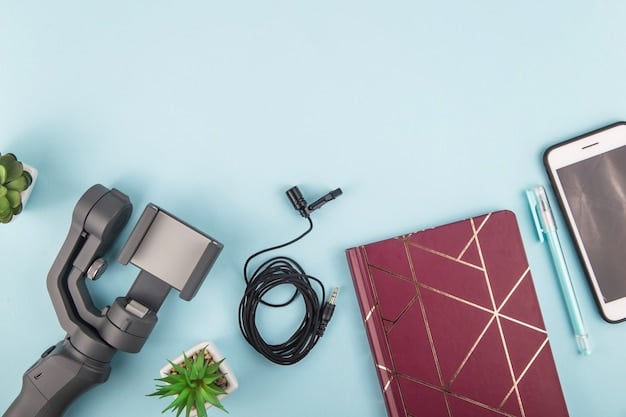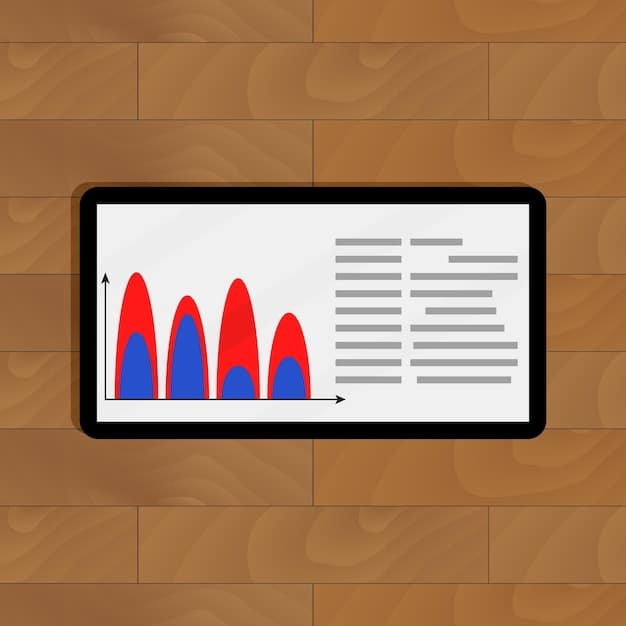Maximize Your US Podcast: Repurposing for 5x the Content

Podcast content repurposing is the strategic process of transforming a single podcast episode into multiple pieces of content, like blog posts, social media updates, and infographics, amplifying its reach and engaging diverse audiences within the US market.
Are you a podcaster in the US looking to expand your reach and engage with a wider audience? **Podcast content repurposing: Turn one episode into 5 pieces of content for your US Podcast** is a powerful strategy to maximize your efforts. Let’s explore how!
Why Podcast Content Repurposing Matters for US Podcasters
In the competitive podcasting landscape of the US, simply releasing episodes isn’t enough. You need to be strategic to stand out and reach your target audience effectively. Repurposing allows you to extract maximum value from each episode and connect with your audience on multiple platforms.
Extending Your Reach
Repurposing content allows you to connect with individuals who may not consume podcasts regularly. By reformatting your episode into blog posts, social media snippets, or videos, you offer alternative entry points for new listeners.
Boosting SEO and Discoverability
Each repurposed piece of content acts as a new opportunity to improve your website’s search engine optimization (SEO). Using relevant keywords, descriptive titles, and engaging content, you can improve your ranking on search engines.
- Improving brand recognition and visibility.
- Reaching different audiences on various platforms.
- Saving time and resources on content creation.
By repurposing content and optimizing your search engine presence, you make it easier for individuals actively searching for topics related to your podcast to discover you.
Turning One Episode into Five Pieces of Content
The core of podcast content repurposing lies in extracting key themes, stories, or insights from an episode and converting them into different content formats. This includes written, visual, and short-form pieces tailored for different online platforms.
1. The Detailed Blog Post
Transform your podcast episode into a comprehensive blog post. This can be a detailed recap of the main points, supporting information, or unique insights from the episode. Ensure that you include relevant keywords, headings, and subheadings to optimize it for search engines.
2. Interactive Social Media Posts
Create various social media posts using key takeaways from your podcast episode. This can involve quotes, snippets, behind-the-scenes moments, or questions asked during the podcast.
- Increase audience engagement with polls, quizzes, and questions.
- Use audiograms to capture potential listeners.
- Drive traffic to your podcast hosting platform profile.
Sharing valuable content on different platforms can help boost engagement and direct new listeners to your podcast.
Strategies for Effective Content Transformation
Podcast content repurposing isn’t just about copying and pasting. It’s about strategically transforming your content into formats that resonate with specific platforms and audiences. This requires a blend of creativity, adaptability, and technical skills.
One of the most straightforward methods is to transform your episode into a blog post. A blog post can include transcripts, expanded notes from the conversation, and related links or resources mentioned in the podcast.
Visual content stands out in today’s digital landscape. Design engaging infographics that summarize main points, statistics, or visual takeaways from your episode. Use colors, charts, and icons to make the content visually appealing and easily digestible.
The Value of Audiograms
Using short, engaging clips to attract interest to the full episode. Audiograms visually represent sound with waveforms and captions, capturing the essence of an episode in a snackable format.
Tools and Platforms to Simplify Repurposing
Effectively repurposing podcast content requires the right tools and platforms. These resources streamline the process, save time, and improve the quality of your repurposed content.
Transcription Services
Automatically transcribe your podcast episodes to create written content, scripts for videos, or captions for social media clips. Otter.ai and Descript offer accurate and efficient transcription services. If you’re on a budget, consider using free transcription services such as Google Docs voice typing for quick tasks.
Graphic Design Tools
Use graphic design software to create compelling visuals for social media, infographics, and other promotional materials. Canva offers user-friendly templates, graphics, and customization options for non-designers.

Video Editing Software
If you aim to make short videos from your podcast content, use video editing software. CapCut is a great platform for both desktops and mobile devices that allows you to create shortform content.
- Otter.ai for quick written podcasts or posts.
- CapCut for short-form video editing.
- Canva for engaging visual appeal.
Measuring the Success of Your Content Repurposing Efforts
Monitoring your podcast metrics to gauge whether repurposing content is effective is crucial. Keep track of website traffic, social media engagement, and podcast downloads.
Analyze metrics such as website traffic, time spent on page, social media engagement (likes, shares, comments), and podcast subscriptions.
Adjusting Your Strategy
If you find that certain types of repurposed content are more successful than others, allocate more resources to those formats. If a particular social media strategy generates more engagement, refine it for future campaigns.
Content creation should be data-driven so you can make decisions on where to allocate more time.
| Key Point | Brief Description |
|---|---|
| 📣 Extend Reach | Reach new audiences on multiple platforms by repurposing content. |
| 📈 Boost SEO | Improve search engine ranking with optimized content on various channels. |
| ⏱️ Save Time | Maximize content value and save time by repurposing existing episodes. |
| 🎨 Visual Appeal | Create engaging and digestible visuals with tools like Canva. |
FAQ
▼
Repurposing broadens your audience by transforming your podcast into readable and easily shareable content. This enhances your ability to engage with individuals who might not typically listen to podcasts as well. Through social media sharing you can attract potential listeners.
▼
Ideally, repurpose your content regularly, such as one or two episodes per week, depending on your capacity and audience engagement. This keeps your podcast active on various platforms; frequent updates attract more traffic and keep your audience engaged.
▼
Challenges often include lack of time, resources, and technical skills. It also requires creativity to convert content into diverse formats effectively. Managing engagement across multiple platforms is also a significant task.
▼
Track traffic on websites, engagement via social media platforms, and downloads of podcasts. Analytic tools can help correlate these metrics and assess how repurposing influences content performance. Measuring metrics help track your progress.
▼
Consider utilizing website SEO platforms to capture SEO value and boost brand visibility. Use Canva for graphic designs and CapCut for concise video creation. AI tools are useful for tasks, like written content creation.
Conclusion
Podcast content repurposing is a valuable strategy for US podcasters to maximize their reach and engagements. By creatively transforming episodes into multiple formats such as blog posts and infographics, podcasters can connect successfully across various digital platforms. Monitoring these methods and adapting strategies based on performance remains crucial for growing audiences.





